Something that strikes me often about the Melbourne suburbs is their quietness. Walk through most suburbs on a Saturday or Sunday afternoon and you won’t hear much at all, except traffic (on the busier roads), the occasional lawn mower or leaf blower, perhaps the remote sound of a TV, or the bark of a dog behind a gate. More than once I’ve asked myself: where is everybody? I encounter few other walkers as I make my way around, and occasionally feel oddly conspicuous as a solo pedestrian. Sometimes parks are busy, and certain shopping/cafe strips, but many places seem eerily deserted.
The suburbs are not totally silent, though. On the wall of the Collingwood Neighbourhood House in Perry Street I came across evidence of an intriguing psychogeography project: a list of sounds heard by Lauren Brown, ‘listener in residence’. They include the classic audio backdrops to suburban life – birds tweeting, motorbikes, dogs barking, bouncing balls, lorikeets, shopping trolleys – and fragments of dialogue: ‘Dude!’ ‘Can you give me ten dollars?’ ‘Is this still a kindergarten?’
It makes me wonder how different the sounds would have been 50 or 100 years ago. Were there more people in the streets back then? More people walking to local groceries and milk bars for a chat, instead of jumping in their cars? More kids playing footy or chasey in the street? My impression is that suburban streets used to be busier then than now. In some places – like Kensington and Newmarket – the streets would regularly be filled with the din of sheep and cattle being driven to the saleyards. In others there would be factory sirens, the racket of machines, and thousands of people making their way to work from stations and tram stops. (Ah yes, the squeak and scrape of trams – a very Melbourne sound which I’m glad we still have.)
I crossed Hoddle Street and wandered into Abbotsford, a peaceful and comfortable residential suburb. Very quiet – not even any shouts of ‘Dude!’
These days Abbotsford is the kind of suburb offering what real estate agents call “a highly desirable inner city lifestyle” , but it wasn’t always that way. As Graeme Davison wrote in The Rise and Fall of Marvellous Melbourne, in the late 19th century “only a shallow stream and half a mile of steeply rising ground stood between the mansions of Toorak and Kew and the lowly riverside slums [my emphasis] of Abbotsford and Burnley.” The high ground to the east and the low ground to the west made the Yarra a social as well as geographical barrier, a distinction that lingered well into the 20th century.
What traces of the past remain here? At the corner of Yarra and Park Streets I came across a row of terraces with the name of a soap I had never seen before, Scrubbo, on the corner. Around the back, in beautiful condition, was an old favourite – Velvet Soap. Velvet is right up there with Robur and Bushells among the classic Melbourne ghostsigns.
What does the position of these signs tell us? Today most billboards are placed at intersections and on freeways, assuming that we’ll be in our cars to consume their messages, rather than wandering up the street to the grocer with half an idea that we might buy some soap while we’re there. This corner building was probably once a grocer or general store of some kind. It occurs to me – based on no research, just a hunch – that perhaps one reason we see so few people in suburban streets is that the little shops and milk bars that used to cater for local needs have died out, removing some of the reasons for people to walk up the street to buy a litre of milk and have a chat.
While on the theme of ghostsigns, on the walls of one of the buildings attached to the nearby Abbotsford Convent – a place with a grim but fascinating history, which I won’t retell here, but which has now been successfully converted to an arts and cultural space – this rather charming sign can be seen. But it’s not all it seems.
The French advertising for ‘Bois & Charbons’ (wood and coal) is not an original part of the Convent. According to Stephen Banham, author of the excellent Characters: Cultural Stories Revealed through Typography, It was created in 1987 for the documentary Nancy Wake: Codename the White Mouse. Nancy Wake was an Australian who played a heroic role in assisting the French Resistance against the Nazis.
The fake sign, Banham writes, was intended to provide a backdrop to a reconstruction of an occupied French country town during World War Two. These days it’s a popular backdrop for wedding photography, presumably without the addition of men in Gestapo uniforms.
Talking of fakes, I came across an old friend inside a cafe on Johnston Street, not far from Victoria Park station.
There’s nothing fake about the sign – this is perhaps the best preserved Dr Morse sign in Melbourne – it is Dr Morse himself who is bogus. I wrote about the good doctor when I encountered him previously on Abbotsford Street, North Melbourne; as I discovered then, Dr Morse was the creation of American advertising men of the 19th century, a picturesque figure who supposedly learned about native American medicine from the ‘red men’ and brought his knowledge of their secret herbs (Indian roots) to the world in pill form. Nevertheless it is pleasing to find that he has come back to life in 21st century Melbourne – and these days he even has his own line of coffee beans, which certainly have magical properties for Melburnians today.
The nearby station’s main purpose used to be to deliver footy fans to Victoria Park, for more than a century (1892-1999) the home of Collingwood, the quintessentially working class football club. During the Depression of the 1930s, the success of the football team was one of few bright spots. TV footage of matches from the 1950s shows the crowd – more than 40,000 sometimes – pressed up close to the boundary line, almost within touching distance of the players.

The ground hasn’t been used for AFL matches since the late 90s, but a turnstile or two and some weathered signage still evoke the days when tens of thousands would cram into this small ground to watch Collingwood play.

These days, of course, Collingwood play their matches at the MCG, where they are assured of larger crowds, who are kept much further away from the players; like so many other things, professional sport is far from a local activity and has become a global televised spectacle. Football at the highest level, like industry, is now something that happens elsewhere.
Nevertheless, as you walk through the Sherrin stand on a quiet day, with no one around (except a guy doing yoga in the middle of the oval, and someone walking a dog) you hear ghostly fragments of songs, stories, cheers, anecdotes, motivational speeches, laughter from players and spectators’ anecdotes. A soundscape by artist Duke Albada, titled ‘For the Love of it’ has been installed in one of the pedestrian access passages under the stand. You can hear a small snippet here.
While I think it’s great to have artworks installed in venues like this, it strikes me as odd that the sounds of the suburbs are now curated museum pieces. Like the Bois et Charbons sign, it is a carefully constructed simulacra of a reality that no longer exists. You might as well also have sound museums of all the other things that no longer occur in this suburb: factories, shops, kids playing in the streets …
Another artwork at Victoria Park is the sculpture based on the concept of the scoreboard, which my mate Vin Maskell has written about on his site Scoreboard Pressure. Created by sculptor Anderson Hunt, who was present at the demolition of the Victoria Park scoreboard, the work is titled The Final Siren. As far as I know it is the world’s only piece of scoreboard art, but I’m prepared to be proved wrong.
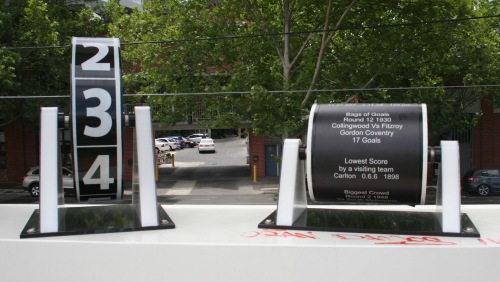
As you wander out of Victoria Park and south along Trenerry Crescent, you encounter various reminders of industrial activity that is long gone. As the crowds have gone from Victoria Park, the workers have gone from places like Yarra Falls mill, whose chimney still peeps out from among the surrounding apartments, a memory of a different kind of suburban lifestyle.
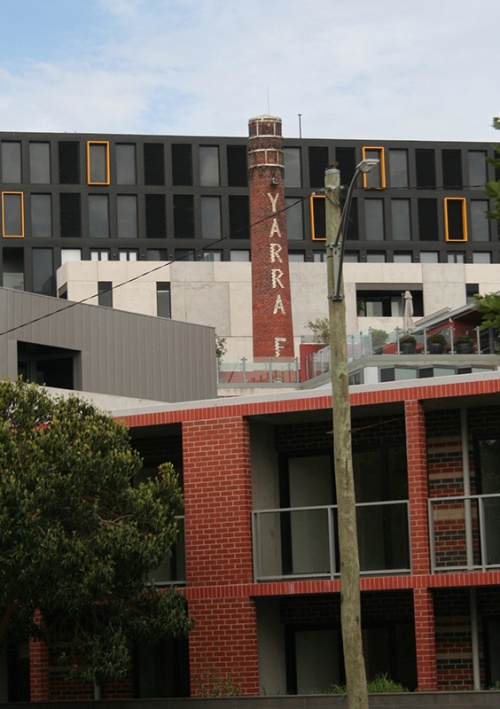
Perhaps the most impressive building in this part of town, and one of the best Victorian buildings in Melbourne, is the evocatively named Denton’s Steam-Powered Hat Mill on Nicholson Street.
The impressive scale of the building – designed by the famous architect William Pitt, and constructed in stages from 1881-1916 – suggests a self-confident Victorian view of manufacturing as a noble activity. Like a Gothic cathedral, it is meant to impress you with the sheer scale of the undertaking, pointing to a great and sublime purpose – not just the manufacture of hats, but of wealth, employment, self-respect, and all the other alleged Victorian virtues. The long, uniform facade with its polychrome brickwork suggests quality, scale and permanence.
The hat factory was a successful manufacturer, and an important local employer, up until 1971; at some stage people stopped wearing hats, even before the more general decline of the clothing industry, and the business closed. The factory, fortunately, was not demolished, and has been converted to apartments. Like the nearby Clifton Hill shot tower, built on a similar scale, it was meant to last. Whatever you think of Victorian capitalism – and working in this factory, or any of the others around here, was no picnic – the calibre of this architecture cannot be denied.
By contrast, most of the commercial buildings that are built in our time have impermanence written all over them – who would dream of building anything like this today?
On a very different note, I spotted a striking piece of street art on a house off Trenerry Crescent. This beautiful piece is evidence of a different kind of suburban life, a creative impulse to make the streets an interesting place to be. It’s just a shame there aren’t more people around to see it.
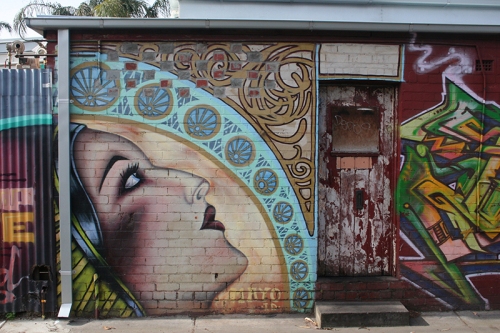
*
For more on Victoria Park, with old photos, check out The Holy Boot.
Read Vin Maskell’s piece on the scoreboard sculpture.
View the walk so far on Google Maps.
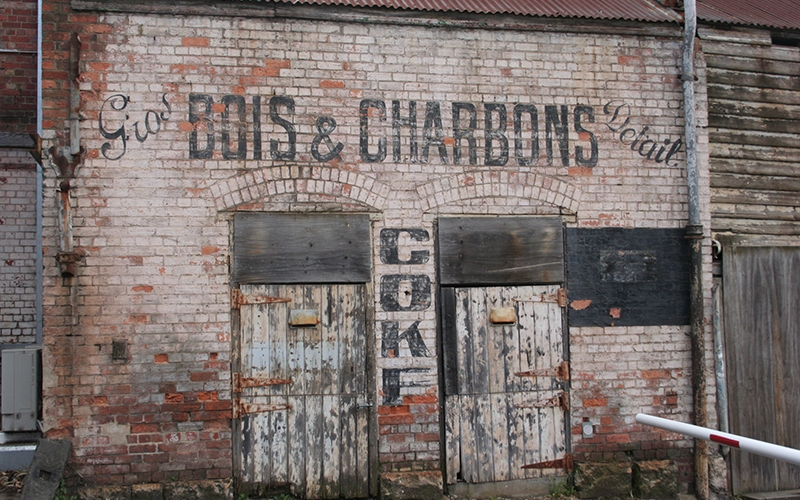
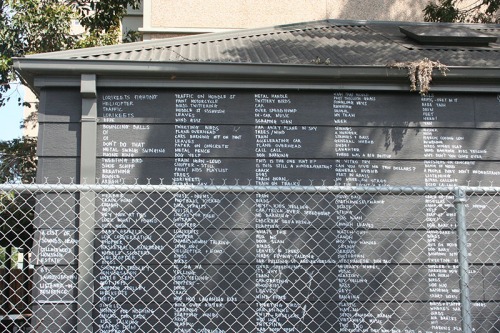


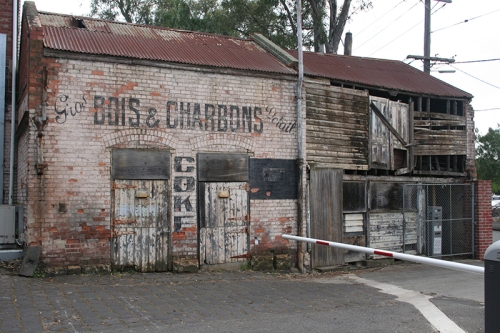
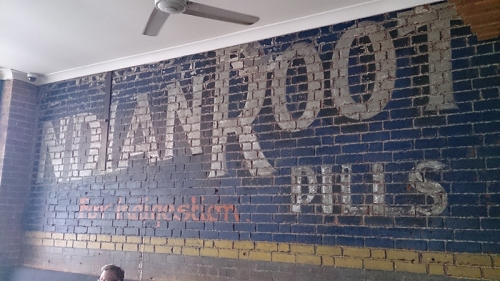





Looks like the Scrubbo Soap sign has an older Persil sign underneath it..another victim of suburban soap wars. There was a fantastic Persil Soap uncovering in Armadale in March last year.
Hi Tony, yes I agree. There’s a story to be told about the suburban soap wars! Thanks
Hi Nick another bottler of a post, and if you had asked the resedents of Abbotsford 1960s what bottler meant they would have translated it as extra special.
Thanks Edwin – your comments are bottlers too!
Did you follow the uncovering of the Indian Root Pills sign in North Fitzroy a couple of years ago? It’s now covered again… almost identical to the one in the cafe. There’s also another (also now hidden) one a block up from the recently uncovered one – see: http://findingtheradiobook.blogspot.com.au/2013/05/another-large-indian-root-pills-signin.html. Plus another faded Dr Morse sign on Victoria Parade in Collingwood I stumbled on recently…near the corner of Wellington Street, up on a first floor.
Great stuff, thanks Stefan. I didn’t see either of those spectacular uncoverings but I have seen the Victoria Pde one. I imagine there are others in hiding, awaiting discovery.
Oh, and also the Chicory Klln in Bacchus Marsh: https://www.flickr.com/photos/gervo1865/15234841754 I didn’t know about the cafe btw – great to see an uncovering being heralded and used to good effect, rather than just covered up. (It must have been an uncovering given the colours are so bright). There’s another great Victorian wall sign (for tobacco if I remember) inside a hairdresser’s shop on Lygon St in North Carlton (or is it Parkville?), west side… a couple of blocks south of Pigdon Street.
Yes, the Dr Morse sign was on the wall of the Victorian shop next door (now a tattoo parlour). They liked it so much they named the cafe after him! I love the way this imaginary doctor just keeps reappearing and being reinvented.
Excellent piece, Nick.
Great post. Victoria Park is still used for footy matches. i saw Collingwoods VFL side flog geelongs VFL side there last year!
Thanks – great that it is still being used for footy.
I am an old time Sign Writer 1957-There was a sign painted on the State Savings Bank wall ,facing the North West wall the bank was on the corner of Little Bourke and Swanston St. Melbourne in the early 60s,by John Nicholls of Buckle Bros, I worked with John on that wall sign, it was a painting of a hand with the thumb facing down with a watch ( clock ) the wording was “time to save at the state savings bank ” I would be very pleased to obtain a photograph of that sign.Robyn Boyd made a comment about the sign in his book Australian Uglyness
Kind Regards Allan Day
Thanks Allan, sounds like a great sign! Perhaps a reader of this blog will be able to help you find a photo.
Thank you Nick would be nice, as in those day we did not have cameras available to us like to day every one is a photographer . John has only passed on, I would like to find a pic for his family